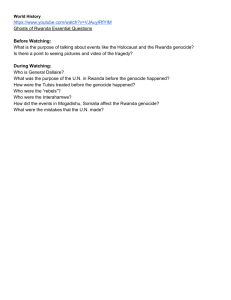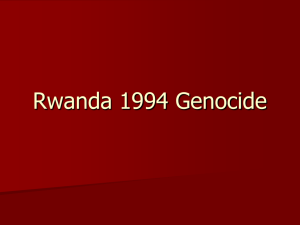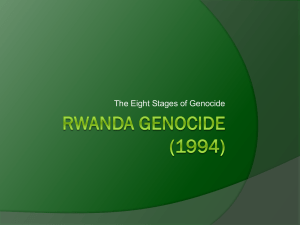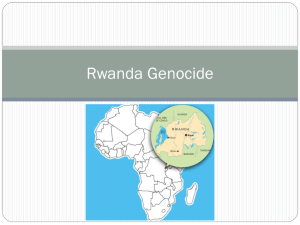Rwanda Student Packet
advertisement
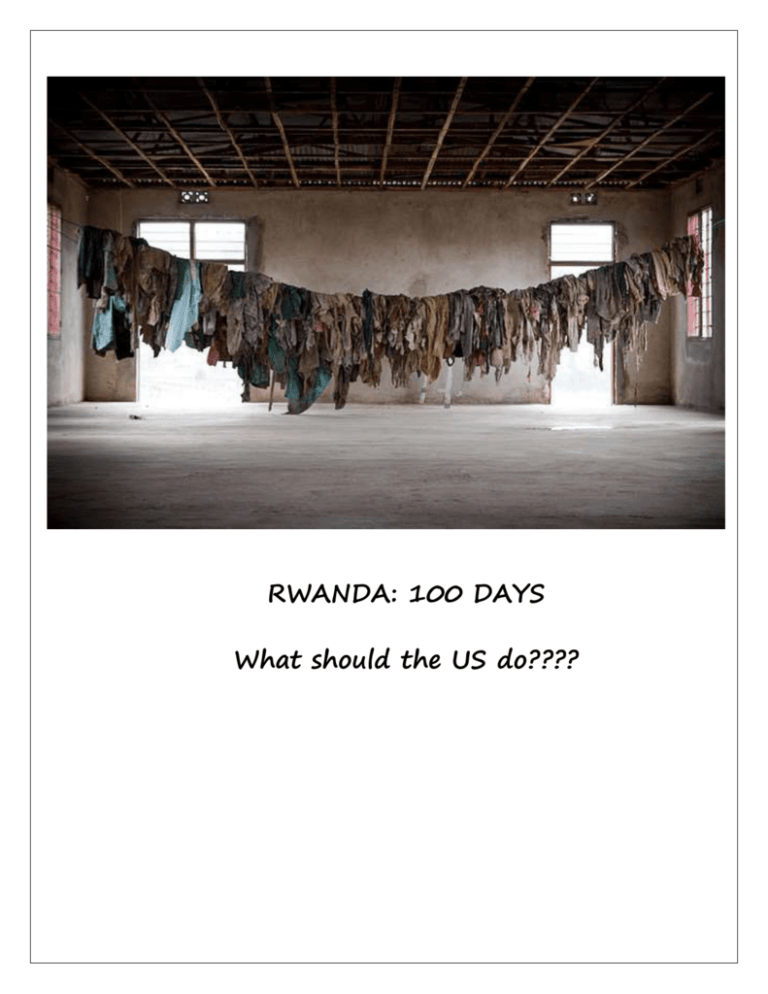
RWANDA: 100 DAYS What should the US do???? Background Essay Genocide in Rwanda Approximately the size of the state of Maryland, Rwanda is a tiny country in central Africa. In Rwanda for hundreds of years three ethnic groups lived together peacefully: the Hutu (85%) and Tutsi (14%) tribes, and the Twa, a pygmy group that makes up 1% of the population. For many years the only difference between the Hutu and the Tutsi was HUTU – 85% of the Rwanda population, once ruled and controlled by the Tutsis, but after Rwanda becomes independent, the Hutu begin to persecute Tutsis. TUTSI – 14% of the Rwanda population. economic. The Hutus were farmers, while the Favored by the Belgians and Tutsis were herders or “ranchers” of cattle. Both eventually the victims of persecution groups intermarried and socialized. When the and attempted genocide by the Tutsis. Belgians took over Rwanda as a colony they favored the Tutsis because they thought the Tutsis were taller with lighter skin and straighter noses. According to the racist ideas of the day, this made the Tutsis more “civilized and intelligent.” Therefore, the Belgians put the Tutsis in control of the country. Even though there were WAY more Hutus, the Belgians made a Tutsi the king and let Tutsis run the country. In 1926 the Belgians introduced identity cards that included an ethnic designation of Tutsi or Hutu. Under Belgian influence Tutsis, by far a minority in Rwanda, were given political and economic advantages including being responsible for the forced labor of Hutus. Eventually the Hutus began to hate the Tutsis and to seem them as working with the Belgian government. In 1959, a few years before Rwanda received independence from the Belgians; the Hutu majority formed a new political party, the Party for Hutu Emancipation (PARMEHUTU), and overthrew the Tutsi monarchy. In a UN mandated and supervised election in September of 1961 the PARMEHUTU won control of the country and Rwanda was granted official independence on January 1, 1962. George Kayibanda became the first president of Rwanda and governed on a platform on Hutu supremacy. The Hutus were now in control of the government that had been oppressing them. In fact, it is during the Kayibanda era that ‘cockroach’ became the most common slang for a Tutsi. Kayibanda controlled Rwanda from 1962 to 1973. During this time, persecution of Tutsis became common enough that many Tutsis fled Rwanda and sought refuge in bordering African countries, especially Burundi. Kayibanda’s government became increasingly corrupt and inefficient in the 1960’s and was eventually overthrown in 1973 in a military coup led by General Juvenal Habyarimana. Habyarimana became the new President. He outlawed the PARMEHUTU and established the National Revolutionary Movement for Development (MRND) as the only political party. His government was corrupt but popular with some European countries, especially France because of the positive trade terms. Kayibanda used the Hutu Power ideology to increase his popularity in Rwanda. Kayibanda continued persecuting Tutsis and this caused many to leave the country. Eventually other African countries started to want Tutsis to return to Rwanda; but when they tried, Habyarimana declared that Rwanda would not accept any returning refugees. In response, Tutsi refugees formed the Rwandan Patriotic Front (RPF). The RPF was a military organization that wanted to fight for control of Rwanda and for the safety of the Tutsis still living in Rwanda. In 1990, the RPF make an attempt to invade Rwanda. With the help of the French government the Rwandan army was able to keep the RPF out of Rwanda. This led to increased tension and racism against the Tutsis remaining in Rwanda. Habyarimana used the rising tide of anti-Tutsi feeling to unify support for his government. He begins recruiting youths into anti-Tutsi “militia” or gangs that are called the Interhamwe. From 1990 to 1992 the Interhamwe increase acts of violence against the Tutsis and the Rwandan military continues minor fighting with the RPF. The international community begins to pressure Habyarimana to decrease anti-Tutsi violence and negotiate with the RPF. In 1993, Habyarimana signs the Arusha Accords. The Arusha Accords say that there will be a government combined from the MRND (Hutus) and the RPF (Tutsis) and that refugees will be allowed to return to Rwanda. The Arusha Accord are never implemented. In fact, Hutu power advocates, including major newspapers and radio stations, began to call for attacks against Tutsis. By March of 1994, many international human rights organizations said that the Tutsis were in grave danger and began to warn the world that violence in Rwanda was about to happen. On April 6, 1994 unknown parties shot down President Habyarimana’s plane when it was returning from peace negotiations between the Hutus and the RPF. Habyarimana was killed. No one knows who shot down the President’s plane. Certain groups believe he was killed by the RPF, while other groups believe that Hutu power extremists shot down the plane because the President was about to implement the Arusha Accords. On April 7, 1994, the Rwandan Armed Forces (FAR), with the help of Habyarimana’s Interhamwe, set up roadblocks and move from house to house killing Tutsis. Thousands are slaughtered by machete and gunfire. The UN troops, already in Kigali (the capital of Rwanda) and around the country to help implement the Arusha Accords are forbidden to intervene. The RPF launches an offensive within days to attempt to stop the genocide, while the UN actually decreases its troops from 2,500 to 250 because 10 Belgian soldiers are killed by the Interhamwe. The US and the UN are hesitant to refer to the violence in Rwanda as genocide on the grounds that identifying the slaughter as genocide commits the West to “prevent and punish” the Hutus based on the Geneva Convention on Genocide. This UN agreement both defines genocide and commits the signatory parties to specific actions regardless of who is committing the genocide. Slaughter in Rwanda continues at an alarming rate. Approximately 8,000 Tutsi and Tutsi “sympathizers” are killed every day. The RPF continues to fight their way across Rwanda to stop the genocide and slaughter of Tutsis. On May 17th, the UN agrees to send troops to Rwanda, but then spend more than a month arguing over who will pay for the troops, supplies, and weapons. By the end of June the UN, who are still waiting for their own troops to deploy, approve the deployment of French troops to aid the RPF in reestablishing order in Rwanda. In July, the RPF take the capital of Kigali and the genocidal Hutu government flees to Zaire. In approximately one hundred days the MRND and the Interhamwe have killed over 800,000 people. They have raped and injured thousands more. Name: Date: Period: Rwandan Background Questions 1. Which ethnic group is larger in Rwanda? 2. Which ethnic group had control of the country under the Belgians? 3. Why do you think it is important that they created ethnic identity cards? 4. What is the PARMEHUTU? What do they believe in? 5. What happened to the Tutsis after Rwanda got independence? 6. How did the Tutsis react to this treatment? 7. What was the Interhamwe? 8. What were the Arusha Accords? 9. What happened to President Habyarimana? Who was responsible? 10. What was the first UN response to events in Rwanda? 11. Why did the West not want to use the word “genocide” when referring to Rwanda? 12. Approximately how many people died per day in Rwanda? 13. Approximately how many people died total in Rwanda? Document A: Convention on the Prevention and Punishment of the Crime of Genocide http://www.hrweb.org/legal/genocide.html Convention on the Prevention and Punishment of the Crime of Genocide - Adopted by Resolution 260 (III) A of the United Nations General Assembly on 9 December 1948. Article 1 - The Contracting Parties confirm that genocide, whether committed in time of peace or in time of war, is a crime under international law which they undertake to prevent and to punish. Article 2 - In the present Convention, genocide means any of the following acts committed with intent to destroy, in whole or in part, a national, ethnical, racial or religious group, as such: (a) Killing members of the group; (b) Causing serious bodily or mental harm to members of the group; (c) Deliberately inflicting on the group conditions of life calculated to bring about its physical destruction in whole or in part; (d) Imposing measures intended to prevent births within the group; (e) Forcibly transferring children of the group to another group. Article 4 Persons committing genocide or any of the other acts enumerated in Article 3 shall be punished, whether they are constitutionally responsible rulers, public officials or private individuals. Article 5 The Contracting Parties undertake to enact, in accordance with their respective Constitutions, the necessary legislation to give effect to the provisions of the present Convention and, in particular, to provide effective penalties for persons guilty of genocide or any of the other acts enumerated in Article 3. Questions: Sourcing: When was this document written? Contextualizing: What major event in world history might have prompted the UN to write this document? Close Reading: How does the UN define genocide? Close Reading: What are countries who sign this document committed to do if there is a genocide being committed? How might this impact US response to genocide in Rwanda? Document B: The Hutu Ten Commandments – as published in Kangura, No. 6, December 1990 http://www.trumanwebdesign.com/~catalina/commandments.htm 1. Every Hutu must know that the Tutsi woman, wherever she may be, is working for the Tutsi ethnic cause. In consequence, any Hutu is a traitor who: Acquires a Tutsi wife Acquires a Tutsi concubine Acquires a Tutsi secretary or protégée 5. Strategic positions such as politics, administration, economics, the military and security must be restricted to the Hutu. 6. The Rwandan Army must be exclusively Hutu. . . . No soldier may marry a Tutsi woman. 9. . . . Hutu must stand firm and vigilant against their common enemy: the Tutsi. Questions: Sourcing: Why did the author write The Hutu Ten Commandments? Close Reading: What does the author say about Tutsi women? Close Reading: What jobs does the author say should be held only by Hutus? How might this impact US response to genocide in Rwanda? Document C: Eyewitness Report From Rwanda – Hamis Kamuhanda, 11 years old in 1994 http://www.historywiz.com/rwanda-eyewitness.htm “The following day we had rumors that Hutus were out to kill every Tutsi in the country, claiming that we, the Tutsis had killed the Hutu president. We were advised to stay indoors. I had never seen my parents so agitated and terrified all my life. Then there was a knock at the door and before we could respond, the door fell in and about four or so people came in and dragged my father out by his legs. That was the last we saw of him. We were hiding under the bed but we could see everything. Mother told us to keep quiet. Then the shooting began. The bullets came in and hit everything in the way. Yet no-one dared scream. Mother could not cover all four of us. I could feel the blood coming from under my right shoulder and I did not know whether I was hit or not. I could not feel any pain then. My mind was occupied with the terror of being hacked to death. Suddenly the door burst open and they came in praising themselves for a good job done. I was closer to the door and they kicked me in my belly. It was painful, but the thought of being severed alive with their machetes, made me stay as quiet as a mouse. One of them said: ’Let’s make sure that he is dead with this.’ I didn’t move an inch, nor did I make any noise, they must have thought that I was dead. I just felt a very sharp pain on my leg and I must have passed out. I don’t know for how long but when I woke up; my mother was nursing my wounded leg. I was trying to look at the wound when I lost consciousness again. The armed Hutu men, the Interhamwe, were scattered and patrolling every corner. The situation was tense for a very long time and we could smell the stench of the dead even inside out fenced house. We were terrified. We thought those men were going to return and realize that we, a Tutsi family were still breathing. . .” Questions: Sourcing: Who was the author of this document? How old were they at the time of the genocide? Cross-Checking: Does this story line up with other documents? Why of why not? Contextualizing: How do you think this family felt during the time they were in their house? Close Reading: Do you find this source believable? What words or phrases does the author use to make this story believable or not? How might this impact US response to genocide in Rwanda? Document D: Memo to the Secretary of State regarding genocide in Rwanda http://www.state.gov/documents/organization/163857.pdf Action Memorandum TO: The Secretary [of State] FROM: George E. Moose, John Shattuc, Douglas J. Berte , Conrad K. Harper SUBJECT: Has Genocide Occurred in Rwanda? ISSUES FOR DECISION Whether (1) to authorize Department officials to state publicly that “acts of genocide have occurred” in Rwanda and (2) to authorize US delegations to international meetings to agree to resolutions and other instruments that refer to “acts of genocide” in Rwanda, state that “genocide has occurred” there or contain other comparable formulations. ESSENTIAL FACTORS Events in Rwanda have led to press and public inquiries about whether genocide has occurred there. In light of the stark facts in Rwanda . . . we believe that Department officials should be authorized to state the Department’s conclusion that ‘acts of genocide have occurred’ in Rwanda. This is the same formulation we used in respect to Bosnia.” Questions: Contextualizing: What is happening in Rwanda that caused this document to be sent? Close Reading: What are the two questions that this document is supposed to address? Close Reading: What is the conclusion of State Department about this issue? How might this impact US response to genocide in Rwanda? Document E: “Ambush in Mogadishu” (edited) http://www.pbs.org/wgbh/pages/frontline/shows/ambush/etc/synopsis.html On October 3, 1993 elite units of the U.S. Army Rangers and Delta Force were ambushed by Somali men, women, and children armed with automatic weapons and rocket-propelled grenades. The Rangers were pinned down in the most dangerous part of Mogadishu, Somalia and taking casualties. What had started out as an operation to capture warlord Mohammed Farrah Aidid - - turned into a tragic firefight that lasted seventeen hours, left eighteen Americans dead, eighty four wounded and continues to haunt the U.S. military and American foreign policy. The ‘battle of Mogadishu’ – a planned 90-miunte mission which turned into a deadly 17 hours – is generally forgotten by most Americans. But five years later it continues to cast a long shadow on US military thinking and decision making about humanitarian/peacekeeping operations. Its legacy, say many experts, was a continuing US reluctance to be drawn into other trouble spots. . .” Questions: Sourcing: Is this a primary or a secondary source? Contextualizing: How might Americans feel about the Battle of Mogadishu? Close Reading: What impact does the author claim that the Battle of Mogadishu had on US foreign policy? How might this impact US response to genocide in Rwanda? Document F: Genocide Statistics, Taken from SURF Survivors Fund, Supporting Survivors of the Rwandan Genocide http://survivors-fund.org.uk/resources/rwandan-history/statistics/ Over the course of 100 days from April 6 to July 16 1994, an estimated 800,000 to 1 million Tutsis and some moderate Hutus were slaughtered in the Rwandan genocide. A recent report has estimated the number to be close to 2 million. During this period of terrible slaughter, more than 6 men, women and children were murdered every minute of every hour of every day. There are between 300,000 to 400,000 survivors of the genocide. Between 250,000 and 500,000 women were raped during the 100 days of genocide. Up to 20,000 children were born to women as a result of rape. More than 67% of women who were raped in 1994 during the genocide were infected with HIV and AIDS. In many cases, this resulted from a systematic and planned use of rape by HIV+ men as a weapon of genocide. 75,000 of survivors were orphaned as a result of the genocide. Questions: Sourcing: Why do you think this document was written? Close Reading: List two statistics that you find shocking. Contextualization: How do you think it would be to live in Rwanda at this time? How might this impact US response to genocide in Rwanda? Name: Date: Period: Rwanda: 100 Days Assessment STEP ONE: Brainstorm ten tools the US could use to respond to the events in Rwanda from April to July of 1994. 1. 2. 3. 4. 5. 6. 7. 8. 9. 10. STEP TWO: Complete the graphic organizer below with five of your best ideas from STEP ONE. IDEA #1 • Positive Outcomes: ____________________ • Negative Outcomes: IDEA #2 • Positive Outcomes: ___________ __________ • Negative Outcomes: IDEA #3 • Positive Outcomes: ____________ __________ • Negative Outcomes: IDEA #4 • Positive Outcomes: _____________ __________ • Negative Outcomes: IDEA #5 • Positive Outcomes: ________________________ • Negative Outcomes: STEP THREE : List three to five steps you think the US should take in response to the events in Rwanda. Then, try to find which documents support your idea. This is a variation on the bucketing assignment. Action #1: Action #2: Action #3: _________________________ _________________________ _________________________ Action #4: Action #5: _________________________ _________________________ STEP FOUR: Create a sample outline for your intro, one of your actions, and the counter argument. I. Tell the President what goal of foreign policy would be met by your actions in Rwanda. (Be sure to review your notes on the five goals of foreign policy) Explain how this goal is being met by the actions you suggest. II. Responses A. Tell the President one response that you think the US should take in response to events in Rwanda. Be sure to explain why your reaction is appropriate based on the sources you read. III. Counter Argument – explain why some people might think your responses would be bad. Then, (here’s the fun part) tell them why they are wrong!!! I. Statement of goal: ______________________________________________________________ II. Responses A. Action#1: _________________________________________________________________ 1. Documents that support your choice: __________, __________, _________ 2. Quotations??? _____________________________________________________ ____________________________________________________________________________ B. Action#2: _________________________________________________________________ 1. Documents that support your choice: __________, __________, _________ 2. Quotations??? _____________________________________________________ ____________________________________________________________________________ C. Action#3: _________________________________________________________________ 1. Documents that support your choice: __________, __________, _________ 2. Quotations??? _____________________________________________________ ____________________________________________________________________________ III. Counter Argument: A. Why might someone think you are wrong? _______________________________________________________________________________ _______________________________________________________________________________ _______________________________________________________________________________ B. Why are THEY wrong and you are right? _______________________________________________________________________________ _______________________________________________________________________________ _______________________________________________________________________________ STEP Four: Now write a brief memo to the President of the United States that outlines your recommendations for US foreign policy to Rwanda . You may choose any of your ideas or combine different ideas to create a plan. However be sure to include each of the following: •What is the goal of this foreign policy? •What tools are being used to meet this foreign policy? •What are some reasons the US should use this foreign policy? •COUNTER ARGUMENT: What are some objections other people might have to this foreign policy? •How do you defend your foreign policy from these objections? ____________________________________________________________________________ ____________________________________________________________________________ ____________________________________________________________________________ ____________________________________________________________________________ ____________________________________________________________________________ ____________________________________________________________________________ ____________________________________________________________________________ ____________________________________________________________________________ ____________________________________________________________________________ ____________________________________________________________________________ ____________________________________________________________________________ ____________________________________________________________________________ ____________________________________________________________________________ ____________________________________________________________________________ ____________________________________________________________________________ ____________________________________________________________________________ ____________________________________________________________________________ ____________________________________________________________________________ ____________________________________________________________________________ ____________________________________________________________________________ ____________________________________________________________________________ ____________________________________________________________________________ ____________________________________________________________________________ ____________________________________________________________________________ ____________________________________________________________________________ ____________________________________________________________________________ ____________________________________________________________________________ ____________________________________________________________________________ ____________________________________________________________________________ ____________________________________________________________________________ ____________________________________________________________________________ ____________________________________________________________________________ ____________________________________________________________________________ ____________________________________________________________________________ ____________________________________________________________________________ ____________________________________________________________________________ ____________________________________________________________________________ ____________________________________________________________________________ ____________________________________________________________________________ ____________________________________________________________________________
